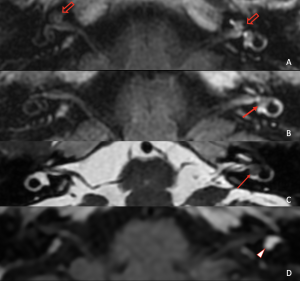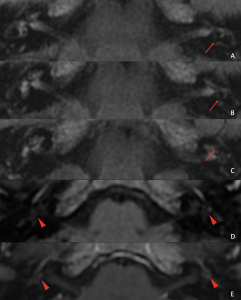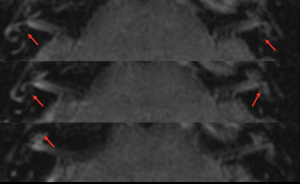All in all, we found 160 MRIs that included the late-enhanced 3D-FLAIR sequence in their protocol. Of these patients, 4 were found to have secondary endolymphatic hydrops.
In all cases, patients prestented with a triade of vertigo, tinnitus and hearing loss and the diagnosis of MD was suspected.
Case #1 was a patient who was suspected of having left-sided MD. On imaging, we found a dilated cochlear canal on the left side as well as an intravestibular schwannoma. We conluded to a secondary cochlear EH.

The second patient was also a suspected case of left-sided MD. On imaging, we found saccular hydrops as well as an arachnoid cyst of the cerebello-pontine angle (CPA). CPA tumors inluding arachnoid cysts have been described in the litterature in association with symptoms mimicking MD. Most believe that the pathophysiology is secondary endolymphatic hydrops, our imaging is in line with this theory.

The third patient had previously undergone surgery for otosclerosis 4 years prior. After initial improvement, they presented with vertigo, tinnitus and mixed hearing loss. Secondary displacement of the piston-wire prothesis was suspect and a temporal bone CT was performed which came back negative. They were then further investigated using MRI which confirmed the presence of both a cochlear and a vestibular endolymphatic hydrops on the left side.

Patient number 4 presented with bilateral tinnitus, vertigo and hearing loss on the right side. Imaging found bilateral biletaral endolymphatic hydrops. Sequences exploring the infra and subtentorial regions showed signs of intracranial hypotension.

